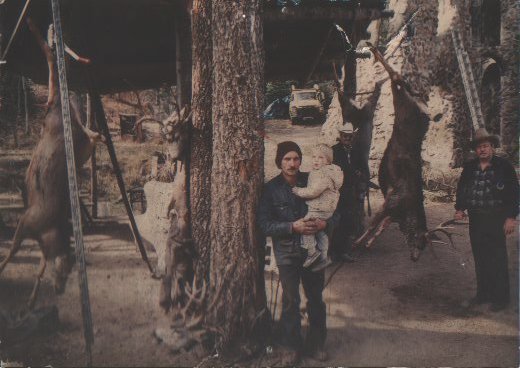It Just Keeps On Growing!
As the castle grew, so did the fame of the man in the mountains pursuing the American Dream – to be the king of one’s own castle! More and more people began visiting, and Jim was frequently asked if he needed help building his castle. For the first eight years, his response was always, “Sure!” Yet, in all those years, not a single person ever followed through on their promise to help. In a fit of cynical frustration, Jim declared, “By God, I’ve gotten this far by myself. If you’re going to do something right, do it yourself!” (along with a few other choice words best left unprinted). Thus, the concept of the castle being a one-man project emerged in the midst of construction; it was not an original intention or a childhood dream, as many might assume. Nevertheless, he continued building. And building. And so, the Bishop Castle continued to grow…
Other Discoveries Along the Way
Numerous features of Bishop Castle were discovered intuitively or emerged spontaneously as the construction progressed. Some might even say they “suggested themselves.” During the castle’s construction, Jim also found joy in building his physique. He set up an old army wall tent in the clearing, where he would work out with weights for a couple of hours each evening after a day of building with stone and mortar. As he delved deeper into his weightlifting regimen, he discovered a mental realm where the principles he applied in building could also be applied to his life – striving for balance in everything. This pursuit of balance became an ideal in his self-improvement journey, evident in his stonework, his body, and his mind. Through this approach, Jim began to fully visualize his next steps in construction and how everything would fit together on a grand scale. There were no plans, blueprints, or drawings, except for the one Jim created to illustrate his book, “Castle Building from My Point of View.” The more Jim marveled at how certain features naturally aligned or fell into place, the more he suspected that something greater was at play, perhaps the Creator of All Things working through him in this magnificent endeavor, which seemed to possess a spirit of its own. Jim began to describe Bishop Castle as “Built by One Man with the Help of God.” There seemed to be no other way to explain it. And still, it continued to grow…
Feats of Strength
To realize the full extent of his vision, Jim utilized every resource available to him. He had apprenticed and then excelled in welding and scroll bending under his father’s tutelage at the family’s Bishop Ornamental Iron Shop, learning how various elements fit together for most of his life. Jim undertook every task necessary – hauling rock from state highway ditches, felling timber and milling it into lumber, constructing forms for his arches from railroad ties (reusing the same form repeatedly), and building scaffolding as he progressed. He manually dug holes up to 12 feet deep for the foundations, mixed all his own mortar, and carried it, often uphill, to his work site. He also devised and assembled complex systems of pulleys and come-alongs to hoist items such as tree trunks for floor supports. Stone by stone, his dreams materialized. Remarkably, Jim handled each and every stone in the castle an average of six times before it found its final place in this grand reorganization of scattered granite from the Rocky Mountains into the structure of Bishop Castle.
Structural Ornaments
The construction of the square tower on the south side of the main keep marked the first significant use of ironwork in the castle’s construction. Until then, Jim had used his ironwork skills primarily for window frames, stairs, and decorative elements. However, his use of iron and steel evolved to become structural, starting with a core frame for the tower right from its foundation. The stonework built around this base provided such strength that Jim confidently envisioned the tower reaching even greater heights. Wooden forms on the second floor soon made way for ornamental iron forms in the arches, showcasing some of the most precise examples of geometry in the castle. The most magnificent feature, however, is the inner roof support trusses and the main central arch. These elements are so intricately detailed yet massively functional that it’s astounding to think they are the work of just one pair of hands. Everywhere one looks, there is something to marvel at, such as the hand railing ascending the southwest corner, named Roy’s Tower. Its bizarre twists and turns, all hammered cold into a highly customized shape, are a testament to the extraordinary craftsmanship at play.
The Dream Defined
As the castle expanded over the years, it gained increasing attention, drawing more visitors to this mountainous phenomenon. Friends suggested that Jim should capitalize on the growing attraction. However, Jim had a different perspective. He remembered his own childhood frustrations of being unable to afford visits to the zoo or ballpark due to high admission costs for a working-class family. Since the initial inspiration for the castle came from people visiting the property, Jim decided to welcome visitors for free. He placed a donation box on the property, allowing people to contribute whatever amount they felt comfortable with. This honor system became the project’s financier, reinforcing Jim’s belief that the castle was a symbol of American freedom. He felt that his hard work in Pueblo sufficiently supported his family, and he was content to build the castle to the extent that visitor donations allowed. Although this approach sometimes led to frustrations, particularly when he wanted to construct larger features like an elevator but lacked the funds, Jim remained committed to his vision. He felt so strongly about maintaining the integrity of his dream that he legally documented that Bishop Castle would always remain free to the public. This commitment to the ideals of a free country, composed of free individuals, fueled his passion for building the castle as a tangible, awe-inspiring representation of the American Dream.
Financial Mechanics of Building
After eight years of diligent paperwork, completed without a lawyer’s assistance, Jim’s wife Phoebe achieved what many had deemed impossible. In 1984, she successfully obtained a 501(c)(3) non-profit charter from the IRS, enabling the creation of the Bishop Castle Non-Profit Charitable Foundation for Newborn Heart Surgery. This achievement formalized the castle’s ability to set up and maintain a donation box on the premises, which became a key funding source for its construction. Additionally, Phoebe established the first gift shop in a one-room log cabin, built by the family across the courtyard from the castle, and she managed it for 13 years. The combined proceeds from the gift shop and the donation box were crucial for purchasing materials for ongoing construction. Although the management of the gift shop has changed hands twice since Phoebe stepped down, both the shop and the donation box remain the primary financial sources for the Bishop Castle’s construction.
The charity established by the family aims to assist local families with medical expenses for young children not covered by insurance. Despite the IRS informing the Bishops that they were not obligated to make any donations through the charity until the castle’s completion, they have operated the Charity for Newborn Heart Surgery in such a way that it has made numerous contributions over the years. The Bishops take pride in possibly being the only charitable foundation in the United States created and sustained by working-class individuals.
Enter The Dragon
In the mid-1980s, a friend of Jim’s, while transporting a truckload of discarded stainless steel warming plates from Pueblo County Hospital to the landfill, realized that Jim could make better use of this trove of expensive stainless steel than the dump could. Consequently, he delivered it to the Bishop Ornamental Iron Shop. Jim dedicated that winter to constructing a chimney from the steel, meticulously riveting thousands of hammered “scales” he had fashioned from the plates around a steel frame. By spring, the dragon was complete. Jim then faced the formidable challenge of transporting and installing this remarkable sculpture. It now sits majestically, perched eighty feet high off the front of the Grand Ballroom. The dragon’s transformation into a true fire-breathing spectacle came later with the addition of a burner, donated from a hot air balloon, which Jim ingeniously placed in the dragon’s throat.
Unimaginable Heights Reached
Jim is often told that he must not be afraid of heights. He believes that since he started building from the bedrock base of the earth and has been gradually working his way up, the increase in height has been so gradual that he became as comfortable with it as he is on the ground. This experience can be likened to the difference between watching a child grow daily and seeing them after a year’s gap. The former is hardly noticeable, while the latter is striking in its effect. Jim’s involvement with the castle has been so intimate—he’s handled every single stone there an average of six times—that he has grown with the structure, stone by stone, and the heights do not bother him. In 1994, Jim reached a point with the square Andreatta Tower, named after the family that donated the old school bells housed within, where he felt it was sufficiently high. However, this satisfaction was short-lived. In 1995, he constructed and installed a thirty-foot-tall steel steeple atop the masonry, elevating the total height to approximately one hundred and sixty feet, akin to a 16-story building. To this day, Jim is content with the overall height of his castle. However, he has recently toyed with the idea of extending one of the corner outer wall towers to 250 feet, a whimsical response to a local zoning official who told him he couldn’t build over 25 feet—he simply added a zero.
As It Stands
Today’s visitors to Bishop Castle are greeted by an impressively monumental structure of stone and iron, a resounding testament to the beauty and glory of not only having a dream but also steadfastly pursuing it. It exemplifies the belief that with self-confidence and perseverance, anything is possible. The castle features three full stories of interior rooms, including a Grand Ballroom, soaring towers, and bridges offering vistas spanning a hundred miles. Its Fire-Breathing Dragon adds to the uniqueness of the Bishop Castle, making it an unforgettable experience. Visitors are always welcome free of charge, and the castle is perpetually open. Guests are kindly requested to respect and honor this trust during their visit.


